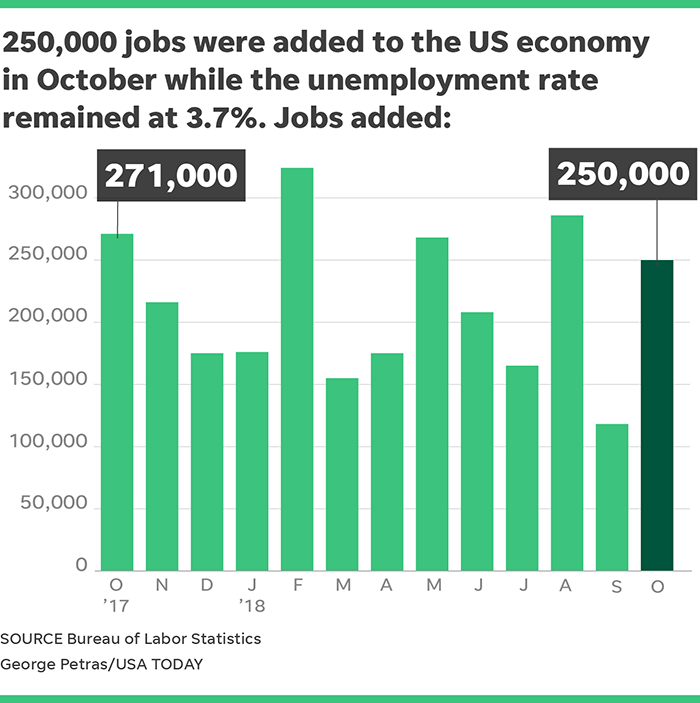The economy added a healthy 250,000 jobs in October, the Labor Department said Friday in the last employment report before midterm elections that President Donald Trump has cast as a critical referendum on his stewardship of the economy.
The unemployment rate was unchanged at a near 50-year low of 3.7 percent. Annual wage growth topped 3 percent for the first time in nine years.
Economists had estimated 200,000 jobs were added last month, according to a Bloomberg survey.
Trump has boasted that low unemployment is a result of the cuts to taxes and regulations championed by his administration and warned that electing Democrats would reverse the gains.
“At stake in this Election is whether we continue the extraordinary prosperity we have achieved – or whether we let the Radical Democrat Mob take a giant wrecking ball to our Country and our Economy!” he tweeted this week.
Economists, however, say there likely would be no significant impact on the economy and labor market if the House or Senate flipped to Democratic control.
Politics aside, the significance of Friday’s report was tempered by the effects of recent hurricanes. Hurricane Florence appeared to reduce employment by 50,000 in the Carolinas in September, likely leading to a similar-size boost last month as workers returned to job sites, Goldman Sachs estimated. Payrolls increased by just 118,000 in September.
But the research firm expected that to be largely offset by a decline of 20,000 to 40,000 jobs as a result of Hurricane Michael, which battered the Florida Panhandle. Goldman expected a net 15,000 bump from weather effects.
Monthly job growth has averaged a sturdy 212,000 this year, up from 182,000 in 2017, despite low unemployment and related labor shortages that are making it harder for businesses to find workers.
“Businesses have started relaxing their (hiring) standards,” says Joel Naroff of Naroff Economic Advisors. “They’re being more rational. That’s why we’re seeing sustained strong job growth” despite the smaller supply of available workers.
Wage growth tops 3 percent
Average hourly earnings rose 5 cents to $27.30, pushing the annual gain to 3.1 percent, strongest since April 2009, from 2.8 percent in September.
But there’s a caveat. Average pay in October 2017 was particularly weak, likely inflating the yearly increase. More broadly, pay increases are gradually picking up as employers struggle to find workers. That could prompt the Federal Reserve to raise interest rates more rapidly to head off a potential spike in inflation.
Industries that are hiring
Health care led the job gains with 46,000. Leisure and hospitality added 42,000; professional and business services, 35,000; and transportation and warehousing, 25,000.
Manufacturers added 32,000 jobs as the industry continued to benefit from a surge in oil drilling and a generally healthy global economy. The effects of the Trump administration’s tariffs on Chinese imports valued at $250 billion a year and China’s countertariffs have dinged business confidence, but that hasn’t yet significantly dampened hiring.
And construction added 30,000 jobs despite severe worker shortages as builders respond to a housing supply crunch.
More workers re-enter vibrant labor market
The share of Americans working or looking for jobs rose from 62.7 percent to 62.9 percent, highest since July, as the favorable labor market drew in more people on the sidelines. The measure, known as the labor force participation rate, has been roughly stable since 2014 despite baby boomer retirements as discouraged workers and others who have stopped looking for jobs restarted their searches.
But as the pool of those workers on the margins shrinks, economists expect participation to resume its longer-term decline, pushing down unemployment.
What it means
There’s is very little not to like in this report. Employment surged by 250,000. Yearly pay increases topped 3 percent. And unemployment remained at a near 50-year low. Trump is likely to cite the blockbuster number the next few days ahead of Tuesday’s election.
To be sure, the big payroll total was partly fueled by workers in the Carolinas returning to jobs after staying home during Hurricane Florence in September. But employment gains for September and October still averaged a solid 184,000.
The strong additions and low unemployment rate almost certainly keep the Fed on track to raise its key interest rate in December for the fourth time this year. Higher rates have played a role in cooling off the stock market by making less risky bonds relatively more attractive.



Leave a Reply